News
6G-EWOC @ ECOC in Copenhagen
6G-EWOC has been well-represented at ECOC 2025, Europe’s largest conference on optical telecommunications. Three contributed papers were presented by Florian Honz and Bernhard Schrenk from AIT, including hybrid radio / free-space optical communication using a shared-aperture air interface, beamforming assisted optical wireless communication between a mobile user and an optical hotspot, and the adoption of wavelength division multiplexing in visible-light communication, where white and thus colorless light-emitting diodes serve as data emitter. Besides the presentation of scientific papers, Bifrost Communications showcased its quasi-coherent transceiver pluggables in its exhibition booth, demonstrating high-speed fiber-optic communication through highly simplified coherent optics.
See our publications page for more technical details.
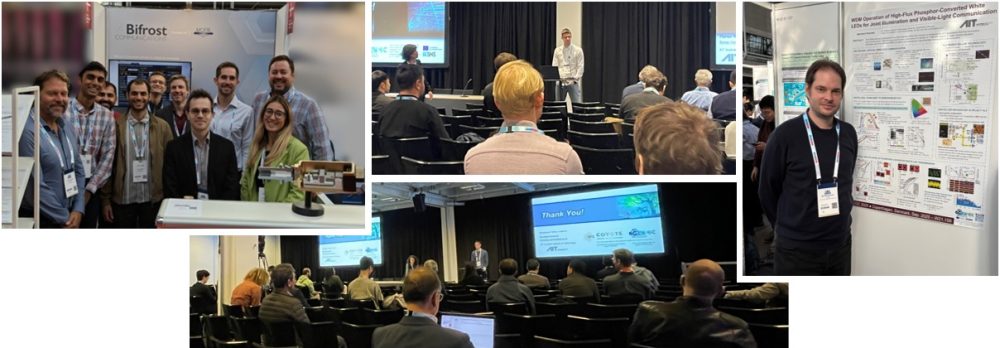
Strong presence at ICTON 2025
Several 6G-EWOC researchers were attending this year’s anniversary edition of the ICTON conference in Barcelona, where our project-related findings were reported through three invited and two contributed papers.
J.A. Lazaro from UPC presented the 6G-EWOC test-bed and work on a digital twin for 5G networks, as well as RaDAR to RaDAR communications to support integrated sensing and communication.
J.M. Ramirez from III-V Lab discussed strategies for and challenges related to heterogeneous photonics integrated circuits, highlighting the quasi-coherent receiver of 6G-EWOC.
An in-depth discussion on the system-level performance for quasi-coherent reception was provided by J.A. Altabas from Bifrost Communications, who presented results towards metro, access and fronthaul networks.
Finally, B. Schrenk from AIT shed some light on 6G-EWOC’s recent advances on beamforming-assisted free-space optical Fi-Wi-Fi links.
After a short summer break, we’ll be back at the ECOC conference in Copenhagen to present further results deriving from 6G-EWOC.
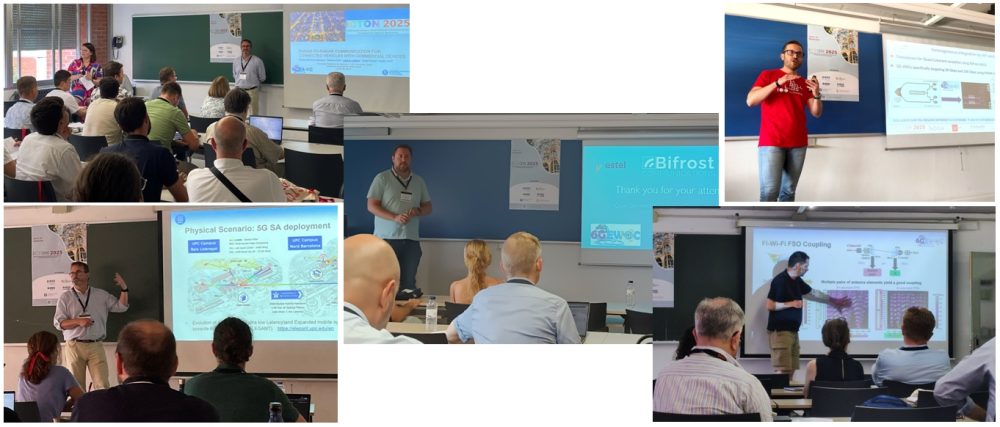
6G-EWOC at EuCNC / 6G Summit 2025
Clustering activities among 6G research projects is essential to disseminate own findings and to cross-pollinate across research initiatives. Towards that ambition, 6G-EWOC contributed to the European Conference on Networks and Communications in Poznan, Poland.
Our researchers contributed to two workshops. José Antonio Lázaro from UPC delivered a talk on how to implement a comprehensive approach to verify key performance indicators across multiple demonstrators at the “6G experimentation methodologies, pitfalls and best practices” workshop. In addition, Bernhard Schrenk from AIT participated in the “Optics and Photonics Innovations” workshop where he presented the project findings towards optical wireless in support of a computing-communication continuum, including I2I fronthaul and V2I / V2V optical access technologies.
Besides delivering our view, EuCNC, which is recognized as the European 6G Summit, provided us with a great opportunity to network with our partner projects. We look forward for the next EuCNC / 6G-Summit and its exhibition.
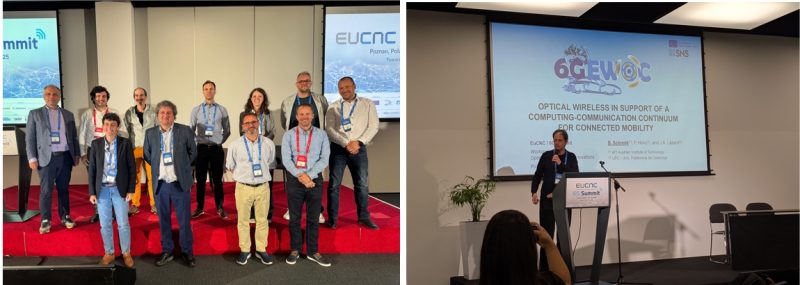
Announcement: 6G-EWOC at the Catalan Mobility Day 2025
Discover the future of mobility with UPC and Beamagine from the 6G-EWOC SNS project as they showcase the sensorized vehicle and share their latest advances in AI for automotive applications. Join them in Manresa on May 30 for the Catalonian Mobility Day and explore how 6G-EWOC is shaping automated driving.
Stay tuned for an update.
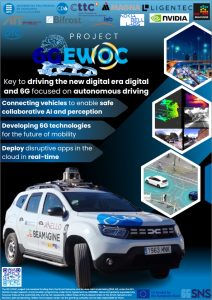
6G-EWOC at ICMLCN 2025
6G-EWOC contributed two-fold to the International Conference on Machine Learning for Communication and Networking, which took place in Barcelona in May 2025. This conference addresses the challenges that reside when deploying 6G networks that require an efficient orchestration and control of all resources deployed at their physical-layer infrastructure.
José A. Lázaro from UPC introduced quantum machine learning to facilitate network intrusion detection in software-defined networks, to monitor and analyze network traffic in an efficient manner for ultimately enabling the identification of malicious activities or policy violations.
Moreover, Josep M. Fàbrega and Ricardo Martínez from CTTC organized a special session on AI/ML for Optical Networks and Communications.

Back to Athens: This was our 4th Plenary Meeting...
The 6G-EWOC partners met again in Athens – this time putting the prime emphasis on planning demonstration activities. With the technical development work packages progressing, time has come to explore how the constituent technologies can enrich the demonstration of 6G support for automated mobility. Three demos will be conducted, focusing on optical wireless connectivity, mobile fronthaul transmission and a more complex consolidating demo on connected mobility.
We thank Nvidia for taking care of the organization of this plenary meeting.

Back to School: 6G-EWOC Delivers Hands-On Experiments for Physics Courses
Visits to schools is one of the science comms activities anchored within larger research projects. An elegant way to explain science in a way comprehensible to the general public and young students is to get them in touch with hands-on experiments. For this purpose, the team of AIT visited a middle school in Vienna to enrich two physics lab courses of second-grade classes of the school’s scientific branch.
Within each of the lab courses, students were able to grasp the physics behind light, including basics concepts from optics such as refraction, reflection and diffraction. Music was streamed over a jet of water to resemble fiber-optic channels that convey light based on total internal reflection. Water samples were analyzed through a simplified microscope consisting of nothing more than a droplet of water, yielding a 500-fold magnification that enabled the students to see fine-grained organic particles within the liquid. Diffraction at human and feline hair samples allowed them to precisely determine their widths in the range of 10 to 100 microns. LiDAR allowed them to take a rather unusual class photo with the eyes of a car, while the fringes of light projected by an interferometer were dancing at the rhythm of their voice. These interactive experiments were complemented by further hands-on setups including LiFi to switch between classic music and the latest hits from 2024, thermal imaging to probe the capacity of different chocolate biscuits to store energy, and a virtual journey to the end of the universe, where the physical principles of optics can be found at much large scale, as for example evidenced through gravitational lenses.
As also experienced in the past, the outreach activity was rewarded by the strong interest of the students and a very positive feedback.

To Brave all Turbulences: 6G-EWOC’s Fi-Wi-Fi Bridge Receives Top-Score at OFC 2025
In a contributed paper that has been top-scored (i.e., ranked within the top-10% of all accepted papers) and presented at OFC, 6G-EWOC’s researchers demonstrate the mitigation of optical turbulence – an atmospheric effect that spoils optical free-space communications if left unaddressed. AIT’s team uses a very simplistic diversity scheme that can be smoothly integrated with the 91-element focal plane array beamformer that further simplifies the initial alignment of the Fi-Wi-Fi bridge. The paper has been presented together with another oral paper on VLC.
With over 16,000 registrants from 80+ countries, a showcase of more than 600 exhibiting global companies and more than 750 papers, OFC is the world’s largest conference on optical telecommunications.
For more details, check out the paper preprint on our project webpage.
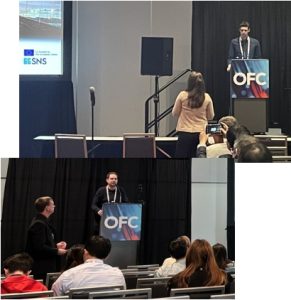
On the Showfloor: 6G-EWOC @ Mobile World Congress 2025
The UPC stand at MWC 2025 showcased innovative research in 6G, AI, and edge computing. Over four days, pioneering prototypes like the 6G-EWOC technology connected academia and industry.
A real-time demo combined MIMO FMCW radar and camera data. While the radar estimated object distances but misclassified types, the camera recognized people yet couldn’t determine distance. The multimodal fusion technology corrected these gaps, associating distances with people and filtering out non-human objects.
But 6G-EWOC showed how intermediate-level fusion improves average precision and collaborative perception combines vehicular sensors at different viewpoints overcoming occlusions, with edge computing and OWC as vital enablers. The presentation concluded with videos showcasing improvements in detection accuracy for Connected Autonomous Vehicles, using both synthetic and real-world datasets, highlighting the transformative potential of these technologies. High-level representatives of 6G-SNS attended the presentation.

A Concerted European Effort: Our Athens Plenary
In November 2024, we held our third plenary meeting. This event was devoted to the current developments in the technology work-packages, which have finalized a first design for the constituent components of our 6G network architecture.
A major discussion point were the demos that have been scheduled for the second project phase and to which technologies on multiple domains (optical wireless, fronthaul and data processing) will seamlessly contribute.
A big thanks goes to OTE for hosting this very productive event!
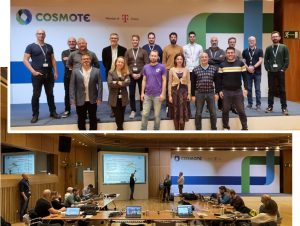
How 6G-EWOC Contributes to Democratized Safety on the Road
The migration to advanced mobile and road infrastructure networks as well as data processing systems with improved performance and reliability supports fully-autonomous vehicles with collective perception capabilities. Through this, 6G-EWOC addresses selected use-cases concerning transportation on the road. One of these aims at improved safety for all traffic participants.
Navigation of autonomous vehicles through complex and busy intersections shall be seamless and collision-free, despite the presence of other road participants including vehicles with similar, lower or no autonomy, vulnerable road-users such as pedestrians, cyclists or e-scooters, and obstacles – in a dynamically changing environment. 6G supports this as it enables traffic participants to gain a comprehensive understanding of their surroundings through collective perception, including the capability to see through obstructions to capture hidden objects and to be informed and predict trajectories. 6G also contributes through fast data processing close to the “event” to minimize delays and enable a realistic digital-twin representation of the traffic scenario. Network slicing guarantees quality-of-service to ensure the prioritization of traffic related to vulnerable road users over less critical one. The availability of cost-efficient sensing and communication system enables democratized safety on the road.
The teams from UPC and Beamagine around Prof. Santiago Royo and Prof. José Antonio Lázaro were able to showcase their technologies towards automated driving and LiDAR during the Smart City Expo World Congress 2024 in Barcelona, in featured TV spots (Catalan broadcaster TV3) and in a local newspaper (La Vanguardia), among other national and local media appearances.

Recap: 6G-EWOC @ Fall Conferences
The 6G-EWOC team was indeed very active this fall. We attended several conferences in the field to disseminate the concept behind our architecture and first experimental results on the development of its constituents.
At the IEEE Future Networks World Forum 2024, we contributed to the symposia on Connected and Automated Mobility and Optical-Wireless Convergence. We presented the implications concerning the introduction of low-latency simultaneous mapping and localization of traffic participants to 6G networks and our approach in accomplishing this challenge – together with optical wireless comms as the bandwidth enabler that permits a late and thus more effective fusion of raw sensor data at the network edge.
At the IEEE CAMAD 2024 and Infocom World 2024 conferences, we had the chance to focus on the architectural aspects that arise when addressing a new vertical through the introduction of a next-generation radio network. With the influx of new sensor and heterogeneous access technologies, the network needs to cater for their perculiarities in order to unleash their full potential.
For more details, check out the paper preprint on our project webpage.

From Fiber to Fiber: How Fi-Wi-Fi Extends Optical High-Capacity Networks
6G-EWOC attended the ECOC 2024 conference to present its novel approach to bridge gaps in its high-capacity fiber infrastructure through its Infrastructure-to-Infrastructure (I2I) optical wireless communication mode.
In this top-scored paper, we demonstrate the efficient coupling between two single-mode fibers, as thin as a human hair, over a distance of 63 meters. We do so by utilizing a beamformer that is inspired by a simple photonic lantern.
For more details, check out the paper preprint on our project webpage.
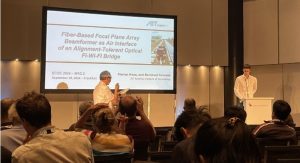
Project Launch: We are on Air!
As one of the newly funded European SNS projects, 6G-EWOC launched its concerted efforts towards a fiber-wireless network infrastructure that supports connected mobility through seamless broadband access between vehicles and datacentres.
The kick-off meeting held in January 2024 and the second plenary in June were primarily devoted to the architecture and requirements definition for a series of mobile use-cases. These will feed the development of the constituent component, system and network technologies in the upcoming months.
The 6G-EWOC consortium builds on 11 partners and is led by the Universitat Politècnica de Catalunya (UPC) as the project coordinator and the Centre Tecnològic de Telecomunicacions de Catalunya (CTTC) as the technical manager. Further partners include the RTO Austrian Institute of Technology (AIT), industrial photonic design and fabrication experts III-V Lab and Ligentec, small and medium enterprises Bifrost Communications and Beamagine specialized in the fields of communication and sensing. The industry end-user perspective will be provided through the mobility technology company Magna, the telecom and datacom system integrators Nokia Bell Labs and Nvidia, and the telecom operator OTE.

